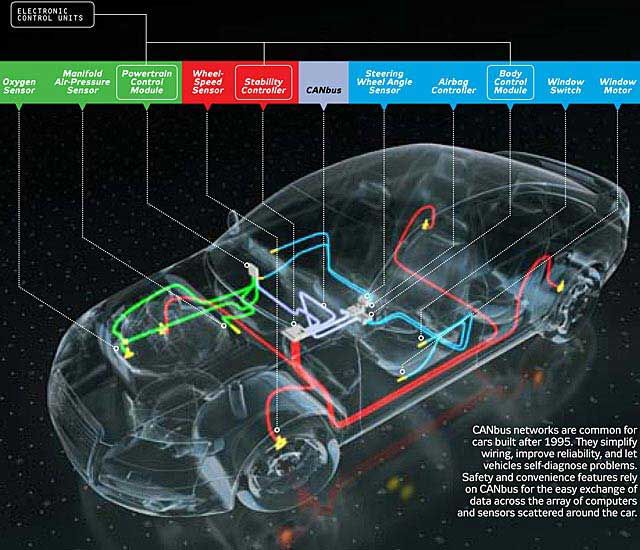
We asked a lot of questions about the bits and pieces of cars that squeak and rattle and break—everything from why is my wheel going clickety-clack to how do I get rid of this rodent smell. But for some time now we’ve seen our inboxes stuffed with questions on the failings of electronic components. That says something about the technological progress of the automobile. Vehicles are increasingly behaving like computers with wheels, so it’s time for a discussion of a little-known aspect of your car: its computer network. In the past we would have called it the electrical system, but its mission has evolved way beyond simply moving dumb electrons. Collectively, these electronics are known as the Controller Area Network, or CAN, but, to be specific, the system of wires and software protocols acting as the connective tissue between a vehicle’s computers and sensors is known as CANbus. CAN allows cars to be smarter, cheaper, and capable of doing some slick stuff that wouldn’t otherwise be possible.
AN INFRASTRUCTURE FOR INFO
We talked to Eric Paton, a technical specialist at Ford, about the intricacies of CAN. Paton says, “If there’s one thing drivers should know when getting into a car, it’s that everything seems simple, but beneath the covers it’s incredibly complex.” The design of CAN is similar to that of a freeway system. Data move like vehicles from high-traffic highways to local roads via on and off ramps. Thousands of data points traverse this freeway at any time along any given stretch and can get off at any exit. Throughout the car are various computers called electronic control units, or ECUs—the traffic lights and intersections of our road-system analogy. Each ECU has several jobs: controlling the engine or transmission, rolling up windows, unlocking doors, and the like. These computers have sensors and switches wired in to detect variables such as temperature, pressure, voltage, acceleration at different angles, braking, yaw and roll of the vehicle, steering angle, and many other signals. When an ECU needs a signal from a sensor connected to an ECU elsewhere in the car, that’s where CAN comes in.
Like a freeway, the CANbus network allows data from all the sensors and computers to circulate around the car at all times. Each computer transmits all its sensor and programming information constantly—as many as 2000 signals are floating around the network at any time, whether they’re being requested or not. At the same time, each ECU “listens” to the network to pluck out pieces of information it may need to carry out its work. There is no central hub or routing system, just a continuous flow of information that’s always available to the ECUs.
Take, for instance, power sliding doors, a common feature on modern minivans. These doors are operated by an ECU called the body control module. Sensors constantly report whether the door is open or closed, and when the driver pushes a button to close the door, the signal from that switch is broadcast across the network. When the ECU gets that signal, however, it doesn’t simply close the door. First, it checks the data stream to make sure the car is in park and not moving. If all is well, it then gives a command to a power circuit that energizes the motors used to close the door. It goes even further, though—the ECU then monitors the voltage consumed by the motors. If it detects a voltage spike, which happens when a door is hindered by an errant handbag or a wayward body part, the ECU immediately reverses the direction of the door to prevent potential injury. If the door closes properly, the latch electrically locks the door shut. In the old days, this would have been an engineering feat. Just electrically powering the doors would have required dedicated wires running between the shifter, the door switch, and the motor.
Before CAN was developed in the mid-’80s, every time an automaker added an electronic feature, like, say, heated seats, new, dedicated wires had to be added just to connect the heaters to a dash-mounted switch. Over the years, more features meant more wires, until there were literally miles of wire in wrist-thick vines snaking all over the car. With CAN, the seat heaters and the switch that powers them don’t have to be directly wired together. They can simply “talk” over the existing CAN network—no special wires needed. What is needed, however, is some additional programming to get all the devices networked. It’s a choice to shift toward programming complexity over physical complexity. CAN has made software development more challenging, but it has had many more positive effects: significant cost savings to the consumer, much lighter weight, reduced reliance on rubber and copper resources, and far better reliability with fewer wires to break over time. Those attributes may be important from a technical standpoint, but the most profound effect of this shift toward programming is on vehicle diagnostics and software updates.
SOURCE: www.popularmechanics.com
